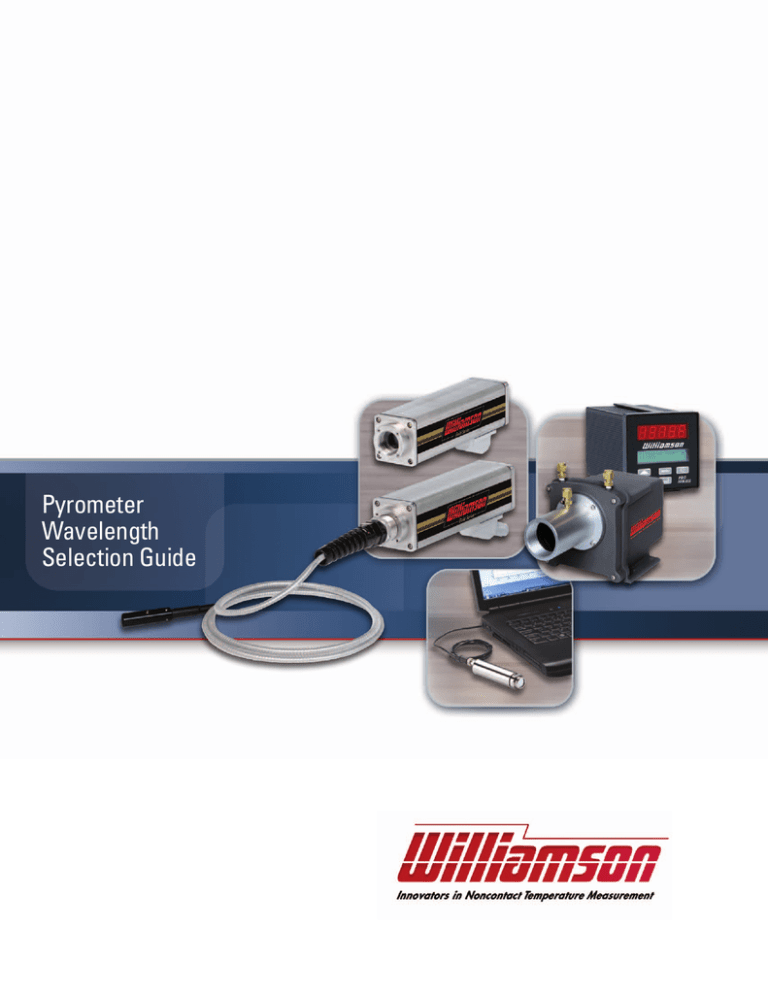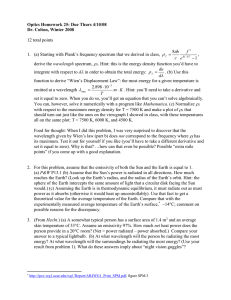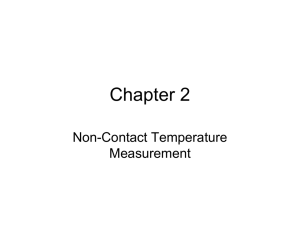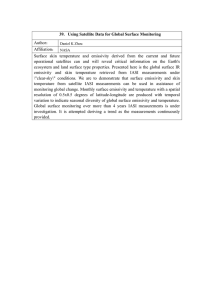Pyrometer Wavelength Selection Guide
advertisement

Pyrometer Wavelength Selection Guide ARE ALL SINGLE-WAVELENGTH INFRARED PYROMETERS ALIKE? Most single-wavelength infrared pyrometers are virtually identical; however, a close look reveals that most sensors are different in one critically important way – the wavelength. Wavelength is an important parameter when selecting an infrared pyrometer because some optical interferences are highly transparent only in specific wavebands. Infrared energy is an electromagnetic energy just like visible light and x-rays. Visible light, different from x-rays only in wavelength, does not pass through the human chest, while x-rays go right through. In a similar way, correct wavelength selection allows an infrared pyrometer to view clearly through some types of intervening media, such as steam, flames, combustion gasses, etc., without introducing an error. Where the below graph is white (shaded), steam, flames and combustion gasses are highly transparent (opaque). Short-wavelength pyrometers with carefully selected wavelengths are able to view clearly through steam, flames or combustion gasses (or long paths of air, for that matter). Therefore, carefully filtered singlewavelength pyrometers provide a significant technical advantage whenever these interferences are present. Wavelength selection is equally critical for other types of optical obstruction. Williamson singlewavelength sensors are the best when oil, water, steam, flames or combustion gasses are encountered. 100 H2O H2O Transmittance % H2O H2O CO2 CO2 CO2 H2O INTERFERENCE 0 0.6 0.8 1.0 1.2 1.4 1.6 1.8 2.0 2.2 2.4 2.6 2.8 3.0 Wavelength µm As an example of the importance of wavelength selection, consider a continuous heat treat furnace with a heating zone, a soaking zone and a cooling zone. When aiming 2 pyrometers, one with a carefully filtered wavelength (Pyrometer A) and one with a broad wavelength (Pyrometer B) about 2 meters into the soaking zone (where the combustion gas and the product temperature are about the same) both sensors will read the same temperature value. However, when the two sensors are moved to the heating 2 zone (where the combustion gasses are hotter than the product) Pyrometer A (carefully selected wavelength), will measure the true product temperature while Pyrometer B (broad wavelength band) will measure about 60˚F / 35˚C too high. Likewise, when the two pyrometers are moved to the cooling zone, Pyrometer A (carefully selected wavelength), will again produce a true reading while Pyrometer B (broad wavelength band) will read about 50˚F / 30˚C too low (because of the cool furnace gasses). Through thoughtful wavelength selection, certain short-wavelength pyrometers can view clearly through even the strongest flames, combustion gasses and clouds of steam without interference. SPECTRAL RADIANCE, W • cm-2 • µm-1 (RELATIVE) SPECTRAL RADIANCE, W • cm-2 • µm-1 (RELATIVE) THE ADVANTAGES OF SHORT-WAVELENGTH SINGLE-WAVELENGTH PYROMETER Short-wavelength infrared pyrometers offer several advantages compared to long-wavelength pyrometers. 1300°C Short-Wavelength Pyrometers – 1200 1300°C • S hort-wavelength pyrometers better tolerate emissivity variation, misalignment and optical obstruction 1100 1200 1100 1000 1000900 900 800 • A vailable in traditional and fiber-optic configurations 800 700 700 0 5 0 5 10 • V iew through common window materials with thoughtful wavelength selection 15 10 15 WAVELENGTH, µm • U niquely view clearly through steam, flames and combustion gasses with thoughtful wavelength selection WAVELENGTH, µm Infrared energy emission is more dynamic at shorter wavelengths meaning short-wavelength sensors are more tolerant to changes in infrared energy (i.e. changes in emissivity or an optical obstruction.) -17 70 8 33 58 83 108 133 158 183 208 233 258 283 308 333 358 383 408 433 458 483 508 533 65 60 55 50 45 40 35 30 25 20 15 10 5 0 0 50 100 150 200 250 300 350 400 8-14µm Sensor 450 500 550 2µm Sensor 600 650 700 750 800 850 900 950 1000 • S elect view through water, oil, wax, glass, plastic, plasma, laser energy, and other interferences • M easure low temperature values rivaling long-wavelength sensors 40 38 36 34 32 30 28 26 24 22 20 18 16 14 12 10 8 6 4 2 0 • M easure broad temperature spans rivaling long-wavelength sensors • A re 4 to 20 times less sensitive to emissivity variation compared to long-wavelength sensors • A re 4 to 10 times less sensitive to optical obstruction compared to long-wavelength sensors • A re 4 to 10 times less sensitive to surface scale & cold spots compared to long-wavelength sensors • A re 4 to 10 times less sensitive to misalignment compared to long-wavelength sensors 1.6µm Sensor Error from 10% emissivity change or 10% optical obstruction. Shorter wavelengths produce smaller errors Williamson places a strong emphasis on shortwavelength single-wavelength sensors because of their better ability to tolerate emissivity variation and optical obstruction. As a result, Williamson is able to use these short-wavelength sensors under a wider range of operating conditions. The result is superior sensor performance under real-world operating conditions. Every day, Williamson short-wavelength single-wavelength pyrometers are used to make measurements that are traditionally considered impossible to make. Normal Spectral Emissivity of Cold Rolled Steel 0.55 0.5 Toulouldian and DeWitt luchi Gaskey Eqn Metallic Theory (Fe@800 C) 0.45 Emissivity 0.4 0.35 0.3 0.25 0.2 0.15 0.1 0 1 2 3 4 5 6 Wavelength (microns) For low-emissivity materials, emissivity is higher and more stable at shorter wavelengths 3 ARE ALL RATIO INFRARED PYROMETERS ALIKE? (e.g. Two-Color and Dual-Wavelength) Two-color sensors are an appropriate choice for many common temperature measurement applications. However, when certain conditions are present such as water, steam, scale, severe temperature gradients, severe or intermittent optical obstruction, flames, combustion gasses, laser energy, plasma, small targets and low temperatures, or when real-time emissivity measurements, measurement condition validation, or calibration stability are required, dualwavelength pyrometers are a more appropriate choice. Most ratio infrared pyrometers are virtually identical; however, a close look reveals there are significant differences between a two-color pyrometer (sandwich detector) and a dual-wavelength pyrometer (single detector with 2 unique wavelengths). In fact, there are 4 distinct differences between the two styles of ratio pyrometer that should be considered for each application. Consideration #1: Wavelength Selection Two-color detector technology dictates a specific wavelength set, while dual-wavelength technology allows for free wavelength selection. Thoughtful wavelength selection permits dual-wavelength pyrometers to better tolerate interference from water, steam, flames, combustion gasses, plasma and laser energy. Thoughtful wavelength selection also permits select dual-wavelength sensors to provide broader temperature spans and to measure lower temperature values – as low as 200˚F / 95˚C. Consideration #2: Signal Dilution Capability The two-color detector set includes two separate detectors – one on top of the other, with the bottom detector “blindfolded” by the one above it. Therefore, most of the energy collected by the sensor never reaches the bottom detector. Without this limitation, dual-wavelength pyrometers can tolerate 20 to 100 times more optical obstruction compared to two-color sensors, allowing dual-wavelength pyrometers to better view through dirty windows and severe optical obstructions and to better measure small or wandering targets that do not fill the sensor’s field-of-view. Consideration #3: Wavelength Separation A bump on the floor causes a table to wobble, but the wobble will be smaller when there is a greater separation between the legs. Similarly, the stability of a ratio sensor is related to the separation between the wavelengths. Because the dual-wavelength pyrometers sets have a greater separation, they are as much as 20 times less sensitive to interference compared to two-color sensors. For example, surface scale on a steel target that causes a 40-60 degree error for a two-color sensor would only produce an error of only 2-3 degrees for a dual-wavelength pyrometer. Likewise, dualwavelength sensors are 20 times better able to measure only the hottest temperature viewed. This is important for applications with a small heated area or a temperature gradient, such as welding or induction heating. Consideration #4: Calibration Drift With two detectors, two-color sensors are prone to calibration drift. With only one detector, any detector drift affects both wavelength equally, and therefore, does not impact the ratio measurement. Dual-wavelength sensors therefore hold their calibration much better than two-color sensors. THE ADVANTAGES OF SINGLE-DETECTOR DUAL-WAVELENGTH PYROMETERS Single-detector, dual-wavelength sensors offer all of the capabilities of two-color sensors plus these added advantages Dual-Wavelength Sensors – • Measure Low Temperatures – as low as 200˚F / 95˚C and above Fiber-Optic 400˚F / 200˚C and above • Provide a Real-Time Measure of Temperature, Ambient Temperature, Emissivity and Signal Dilution • Can Measure Single-Wavelength and Dual-Wavelength Temperature Values Simultaneously • Include ESP Filtering to continuously measure intermittent targets or to eliminate intermittent interferences • S elect models uniquely view clearly through Water, Steam, Flames and Combustion Gasses with thoughtful wavelength consideration • Select models uniquely view through Plasma and Laser Energy with thoughtful wavelength consideration • Are 20 times less sensitive to Scale and temperature gradients compared to two-color sensors • Are 20 to 100 times less sensitive to optical obstruction and misalignment compared to two-color sensors 4 Dual-Wavelength Pyrometers better tolerate emissivity variation, misalignment and optical obstruction. Williamson places a strong emphasis on dual-wavelength pyrometers because of their better ability to tolerate a wide range of common application issues with little or no maintenance. Dual-wavelength sensors are used every day to make measurements that are traditionally considered impossible to make. ABSOLUTE RESPONSIVITY 0.6 0.5 Top Diode 0.4 0.3 0.2 Bottom Diode 0.1 Dual-Wavelength Applications 0 0.6 0.7 0.8 0.9 1.0 1.1 1.2 λμm The Two-Color Detector Design Dictates the Wavelength Set. Note that the two wavelengths overlap without separation, 1.0-1.1 um is a poor wavelength for water, steam, flames, combustion gasses, and silicon, and the long-wavelength (bottom detector) is weak. Transmission thru 0.094 in. of water 60 40 20 TWO-COLOR 80 DUAL TRANSMISSION % 100 Transmission thru 0.375 in. of water 0 0.6 0.7 0.8 0.9 1.0 1.1 1.2 1.3 1.4 1.5 WAVELENGTH (MICRONS) Select Dual-Wavelength Pyrometers View Clearly Through Water and Steam without interference. Two-color Pyrometers do not. 543˚K 623˚K 693˚K 743˚K Emissivity 793˚K 873˚K 1073˚K • Molten Metal Stream (Al, Cu, Fe, Ag, Au, etc…) • Sinter Furnace • Coke Guide • Continuous Caster • Reheat / Heat Treat Furnace • Rolling Mill Descaler • Rolling Mill Stands • Rolling Mill Cooling • Rolling Mill Coiler • Annealing Line Wedge • Forging Die • Wire and Rod • Ultra-Fine Wire • Oilfield Tubular Products • Induction Heating • Severe Optical Obstruction • Aluminum Brazing • Plasma Diamond Growth • Plasma Ion Nitriding • Carbon Densification 1073˚K (800˚C) • Engineered Ceramics 793˚K (510˚C) • Silicon CVD 743˚K (470˚C) • Fly Ash • Flames 873˚K (600˚C) 693˚K (420˚C) 623˚K (350˚C) 543˚K (270˚C) Wavelength (u) Select Dual-Wavelength Pyrometers are filtered in a waveband where silicon has highly stable optical properties. Two-Color sensors are not. 5 WILLIAMSON’S UNIQUE MULTI-WAVELENGTH TECHNOLOGY Some of the more popular multi-wavelength applications include the following materials. The most significant challenge for many infrared pyrometer applications is contending with the complex emissive character associated with the measured material or with challenging measurement conditions. Single-wavelength sensors measure a significant error whenever the emissivity value is highly variable and they can not tolerate a significant optical obstruction. Dualwavelength sensors measure a significant error whenever the change in emissivity is inconsistent at the two measured wavelengths and they assume that any optical obstruction impacts both measured wavelengths equally. When the emissive character of the measured material or when the transmission characteristic of any intervening media does not allow a single- or dual-wavelength sensor to produce an accurate reading, then multi-wavelength technology is recommended. Aluminum & Copper • Extruded Surface • Rolled Surface • Cast Surface • Sheared Surface • Forged Surface • Brazing Operations • Coating Preheat Multi-wavelength pyrometers are used for a variety of applications where traditional infrared pyrometer technologies prove inadequate. Multi-wavelength sensors use ESP Algorithms to adjust for the unique emissive character associated with the specific measured material or measurement condition to produce an accurate measure of temperature and emissivity. There are different algorithms for different materials and for different measurement conditions. The iterative ESP Algorithm is used to first measure the spectral emissive character of the measured material, and then to calculate a measure of both temperature and emissivity. Each Williamson multi-wavelength sensor can hold as many as eight ESP Algorithms. The ability to hold multiple algorithms means that each Williamson sensor can be used for multiple measurement applications. Steel & Zinc • Cold Rolled Steel • High Alloy Steels • Electrical Steel • Zinc-Coated Steel • Shot-Blasted Pipe • Hot Mill Coilers • High Strength Bearings • Motor Rotors The Williamson multi-wavelength infrared pyrometers represent the culmination of nearly four decades of refinement and perfection to the world’s first and most robust commercial multiwavelength product line. Originally introduced in the 1970s, no other multi-wavelength sensor is as precise, as accurate, as robust, as reliable, as versatile, as innovative, or as easy to use. No other infrared pyrometers equal the features or performance of the Williamson multi-wavelength products. No other product can measure such a wide range of materials under such a wide range of conditions over such a wide temperature span and in such a wide range of environments. Williamson multi-wavelength sensors are truly without peers. There are a number of temperature measurement applications for which the Williamson multi-wavelength pyrometer represents the only viable and accurate solution. Comparison of Single, Dual and Multi-Wavelength Infrared Pyrometers on Steel Annealing Lines 125 1λ 100 83 69 Single-Wavelength Pyrometer: Emissivity Setting = 0.3 56 75 42 50 28 2λ 25 0 Μλ -25 Dual-Wavelength Pyrometer: E-Slope Offset = 0.000 14 0 Multi-Wavelength Pyrometer: ESP Algorithm = Annealing -14 -50 -28 -75 -42 0.20 0.30 0.40 0.50 0.60 Surface Emissivity 6 Note: Assumes Strip Temperature of 1400˚F (760˚C) and sensor’s wavelength centered at ~ 1.5 to 1.6 microns Temperature Error in ˚C 150 Temperature Error in ˚F Glass & Plastic • Molds • Plungers • Streams & Gobs Multi-Wavelength Sensors tolerate non-greybody emissivity variation and optical obstruction. Williamson specializes in advanced technologies to compensate for the low and variable emissivity character associated with many industrial applications. Normal Spectral Emissivity of Cold Rolled Steel 0.55 0.5 0.4 0.35 0.3 0.25 0.2 0.15 0.1 0 1 2 3 4 5 Williamson Multi-Wavelength Pyrometers – 6 • P roduce a highly accurate temperature reading for all low emissivity materials Wavelength (microns) Non-Greybody: Emissivity is different and changes differently at different wavelengths. • A re available in traditional and fiber-optic configurations • View through common window materials Single, Dual and Multi-Wavelength Readings Compared to a Reference Thermocouple • M easure low temperatures – as low as 300˚F / 150˚C and above; fiber-optic 400˚F / 200˚C and above Dual-Wavelength (˚F) 900 2 • P rovide a real-time measure of temperature, ambient temperature, emissivity and signal dilution 890 1.8 880 870 1.6 860 Reference T/C (˚F) 840 Multi-Wavelength(˚F) • C an measure single-wavelength and dual or multiwavelength temperature values simultaneously 1.4 830 1.2 820 810 Single-Wavelength (˚F) 800 1 790 780 0.8 Emissivity Temperature (˚F) 850 0.6 750 Emissivity 740 0.4 730 720 • S elect models uniquely view clearly through water, steam, flames and combustion gasses 0.2 710 700 • I nclude ESP filtering to measure intermittent targets or to eliminate intermittent interferences • M easure broad temperature spans ideal for most heating applications 770 760 0 • S elect models uniquely view through plasma and laser energy • T olerate misalignment and dirty optics (select algorithms) Single-Wavelength Error vs Emissivity Steel Strip Annealing Line, Emissivity Setting =0.460 60 35 50 30 • T olerate non-greybody emissivity variation and optical interferance 20 30 15 20 10 10 5 0 0 -10 -5 -10 -20 -15 -30 Temperature Variance (˚C) 25 40 Temperature Variance (˚F) Emissivity Multi-wavelength infrared pyrometers offer several advantages compared to other brands and to other sensor technologies. As a result Multi-Wavelength Sensors can make “impossible” measurements of challenging materials (Aluminum, Zinc, Stainless Steel, Copper, High Alloy Steel, Electrical Steel, Cold Rolled Steel, Molds and Plungers, etc) Toulouldian and DeWitt luchi Gaskey Eqn Metallic Theory (Fe@800 C) 0.45 • S tore as many as eight ESP algorithms for use in as many as eight applications for extreme versatility -20 -40 -25 -50 -30 -60 -35 0.2 0.25 0.3 0.35 0.4 0.45 0.5 0.55 0.6 0.65 0.7 0.75 0.8 Emissivity 7 Unequaled Performance in Temperature Measurement A COMPLETE RANGE OF INFRARED PYROMETERS FOR EVERY APPLICATION WILLIAMSON OVERVIEW With the Silver, Gold, and Pro Series sensors, WIlliamson offers a complete range of infrared pyrometers to provide accurate and reliable measurements for traditional and challenging applications. Silver U Class • The Silver Series offers a choice of miniature, low cost configurations for many general purpose applications. • The Gold Series offers a complete selection of wavelengths, optics, and configurations for traditional and challenging applications including heavy industrial environments. • The Pro Series offers the most advanced capabilities with a complete selection of wavelengths, optics, and configurations for traditional and challenging applications including heavy industrial environments. Class Silver C Class Silver M Class Sighting Single-Wavelength Sensors Silver C, M, & U Line of Sight Gold 20 Line of Sight or Laser Gold 30 Fiber optic w/ Aim Light Pro 40 Visual or Laser Pro 50 Fiber optic w/ Aim Light Gold 20 Dual-Wavelength Sensors Pro 80 Pro 90 Gold 30 Visual or Laser Fiber optic w/ Aim Light Multi-Wavelength Sensors Pro 100 Visual or Laser Pro 200 Fiber optic w/ Aim Light For more details on Single-Wavelength models, see Williamson’s Single-Wavelength Industrial Infrared Thermometers brochure and data sheets. SAMPLE INDUSTRIES SERVED • Iron and Steel • Nonferrous Metal • Industrial Heating, Thermal Surface Treatment • Engineered Materials, Semiconductor • Glass and Ceramics including Bricks, Cement, Glass, and Refractory • Incinerators, Boilers, Rotary Kilns, Flares, Thermal Reactors • Paper, Textile, Plastic, Rubber • Pharmaceutical • Food • Aggregate, Ores, Soil and Asphalt TWA 113 Pro 40, 80, 100 WILLIAMSON CORPORATION 70 Domino Drive, Concord, Massachusetts 01742 TEL: (978) 369-9607 • FAX: (978) 369-5485 • (800) 300-8367 (USA) sales@williamsonir.com • www.williamsonir.com Pro 50, 90, 200




